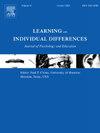Exploring and addressing concerns surrounding L2 grit: A longitudinal perspective
IF 9
1区 心理学
Q1 PSYCHOLOGY, EDUCATIONAL
引用次数: 0
Abstract
Recently, concerns have been raised about the conceptualization, measurement, factor structure, and predictive validity of second/foreign language (L2) grit. The present study aims to address these issues. Data were collected from 223 Iranian tertiary-level L2 learners at three time points over a semester. At each time point, participants completed a questionnaire assessing their L2 grit, L2 self-efficacy, conscientiousness, and self-perceived language proficiency (SPLP). Results indicated that the revised L2 grit scale consisted of two components and demonstrated measurement invariance over time. Furthermore, the L2 grit components increased over time, were longitudinally linked to SPLP, and had small-sized relationships with conscientiousness. Relative weight analysis showed that, in addition to L2 self-efficacy, the L2 grit components were significant predictors of SPLP. The findings suggest that the newly developed L2 grit scale is a psychometrically sound tool for measuring L2 grit.
Educational relevance and implications of the research
Our findings indicated that L2 grit components were related to language learners' self-perceived language proficiency. In addition, we found that L2 grit components changed over a semester. These findings suggest that, first, L2 grit is malleable and subject to change. Second, given its link to L2 achievement outcomes, language teachers should use strategies and techniques to improve their learners' L2 grit.
探索和解决关于L2砂砾的问题:纵向视角
近年来,人们对第二语言/外语(L2)砂砾的概念、测量、因素结构和预测效度提出了关注。本研究旨在解决这些问题。在一个学期的三个时间点收集了223名伊朗三级L2学习者的数据。在每个时间点,参与者完成一份问卷,评估他们的第二语言毅力、第二语言自我效能、尽责性和自我感知语言能力(SPLP)。结果表明,修正后的L2粒度由两部分组成,且随时间的变化具有测量不变性。此外,L2粗粒成分随时间增加,与SPLP呈纵向相关,与责任心呈小尺度关系。相对权重分析表明,除了第二语言自我效能感,第二语言粒度成分是SPLP的显著预测因子。研究结果表明,新开发的第二语言砂砾量表是一种心理测量学上健全的工具。研究结果表明,二语砂砾成分与语言学习者自我感知的语言能力有关。此外,我们发现L2砂砾成分在一个学期内发生了变化。这些发现表明,首先,L2砂砾具有延展性,并且容易发生变化。其次,考虑到它与第二语言成就的关系,语言教师应该使用策略和技巧来提高学习者的第二语言砂砾。
本文章由计算机程序翻译,如有差异,请以英文原文为准。
求助全文
约1分钟内获得全文
求助全文
来源期刊

Learning and Individual Differences
PSYCHOLOGY, EDUCATIONAL-
CiteScore
6.60
自引率
2.80%
发文量
86
期刊介绍:
Learning and Individual Differences is a research journal devoted to publishing articles of individual differences as they relate to learning within an educational context. The Journal focuses on original empirical studies of high theoretical and methodological rigor that that make a substantial scientific contribution. Learning and Individual Differences publishes original research. Manuscripts should be no longer than 7500 words of primary text (not including tables, figures, references).
 求助内容:
求助内容: 应助结果提醒方式:
应助结果提醒方式:


